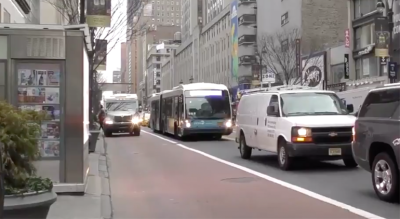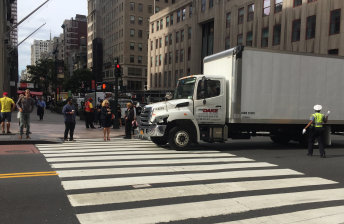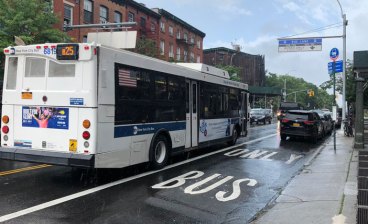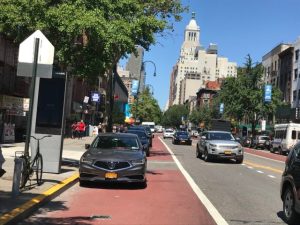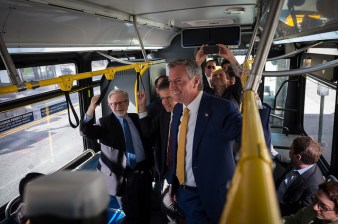Hike in NYPD Bus Lane Enforcement Barely Makes a Dent for Riders
Through September, the NYPD issued three times the number of moving violations than 2017 — but bus speeds remain the same.
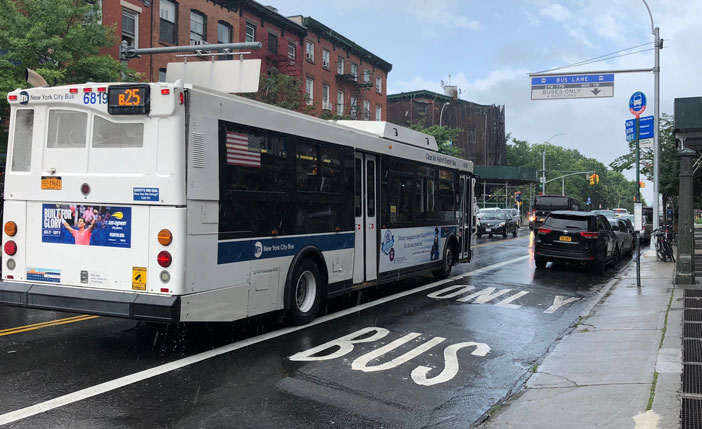
Give NYPD credit for the effort.
The number of bus lane tickets issued by the NYPD is up 16 percent this year compared to the same period last year [PDF – Page 55] — but all that hard work by the men and women in blue has not produced any noticeable improvement in bus speeds.
The NYPD’s growing attention to clearing the path for the city’s 2.5 million bus riders, who endure the slowest service in the nation, is a drop in the bucket compared to the magnitude of the problem, according to Transit Center’s Jon Orcutt, the former deputy commissioner for policy at the city Department of Transportation under Mayor Bloomberg.
“The number of summonses last year was minuscule,” Orcutt said. “Your chances for getting a ticket for being in a bus stop or driving in a bus lane are still pretty slim.”
Through September of this year, NYPD officers issued around 240,000 tickets to motorists driving or parked in bus lanes and bus stops, according to data shared at Monday’s MTA transit committee meeting. The biggest percent increase was in moving violations, which shot up from 1,645 from Jan. 1 through Sept. 30, 2017 to 6,442 during the same period in 2018 [PDF].
Yet it produced only a marginal effect on bus service. Average citywide bus speeds are up .1 mile per hour, or 1.3 percent, to 8 mph from 7.9. Wait times and overall trip times improved by equally tiny amounts.

Overall bus ridership is down 3.5 percent, according to board materials. That’s better than last year’s 6 percent decrease, but a decrease nonetheless.
TransitCenter and the Bus Turnaround Coalition have spent the better part of this year pushing Mayor de Blasio to take the challenge of fixing the city’s buses more seriously. While they’ve applauded him for doing and saying all the right things, a recent report from the coalition cited the continued decline of the bus system as evidence that both NYPD and DOT have more work to do.
“It’s like everything with the city and buses,” Orcutt said. “Nothing is scaled to the actual problem.”
Ultimately, NYPD officers can’t be everywhere at every moment. To truly enforce bus lanes, the city needs authorization from Albany to install more bus lane cameras. State law currently limits camera enforcement to just 16 bus routes.
Camera enforcement is exponentially more effective than actual police officers, which is perhaps one reason NYPD had issued fewer and fewer bus lane tickets in recent years. In 2017, cameras flagged motorists for driving in bus lanes a whopping 133,000 times, according to reporting by NY1.
“We’re happy to see that the NYPD is taking bus lane enforcement more seriously … but it’s also upsetting to see [poor] bus speeds,” said Riders Alliance senior organizer Stephanie Burgos-Veras. “This just shows the need for the state to get involved to make sure we can more bus lane cameras, on a buses, because that will really have an impact citywide.”
Legislation in that vein failed to make it out of committee in Albany this year, but New York City Transit President Andy Byford has committed to increasing the number of bus lane cameras as part of his Bus Action Plan.
“We’re hoping that this time around there will be some additional legislation that will allow increased camera enforcement to improve bus lane availability,” MTA General Counsel James Henly told board members on Monday.
